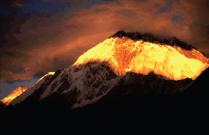
Sunset view of the towering, snow-capped Mt.
Everest, part of the Himalayas. (“The Himalayas”, United States
Geological Survey, Mt. Everest from the village of Lobuche.
Photograph by Gimmy Park Li.
http://pubs.usgs.gov/gip/dynamic/himalaya.html)
|
|
Among the most dramatic and visible creations of plate-tectonic
forces are the lofty Himalayas, which stretch 1800 miles along the
border between India and Tibet. This immense mountain range began to
form when two large landmasses, India and Eurasia, driven by plate
movement, collided. Because both of these continental landmasses
have about the same rock density, one plate could not be pushed
under the other. The pressure of the colliding plates could only be
relieved by thrusting skyward, forming the jagged Himalayan
peaks.
According to the plate tectonic theory, India was a large island
situated off the Australian coast, and a vast ocean separated India
from the Asian continent. When Pangaea broke apart, India began to
move northward. When India rammed into Asia, its northward advance
was slowed, but the two landmasses continue to push on one another
and the Himalayas continue to slowly rise.
At present, the movement of India continues to put enormous
pressure on the Asian continent, and Tibet in turn presses on the
landmass to the north that is hemming it in. The effect of plate
tectonics forces acting on this region is to squeeze parts of Asia
eastward toward the Pacific Ocean. One serious consequence of these
processes is a deadly "domino" effect: tremendous stresses build up
within the earth's crust, which are relieved periodically by
earthquakes along the numerous faults that scar the landscape. Some
of the world's most destructive earthquakes in history are related
to continuing tectonic processes that began when the Indian and
Eurasian continents first met.1
|





